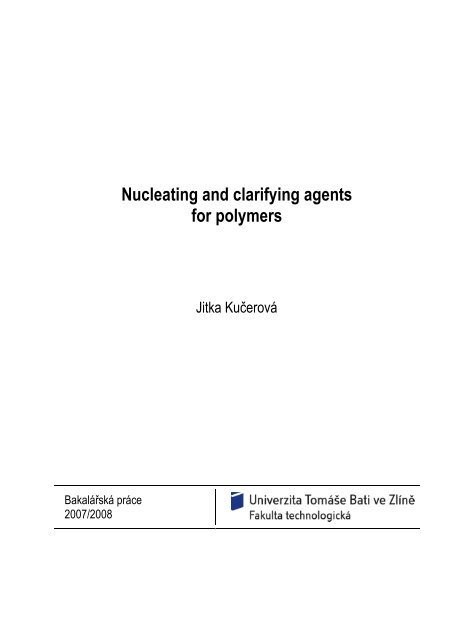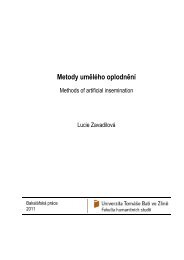Nucleating and clarifying agents for polymers - DSpace UTB
Nucleating and clarifying agents for polymers - DSpace UTB
Nucleating and clarifying agents for polymers - DSpace UTB
Create successful ePaper yourself
Turn your PDF publications into a flip-book with our unique Google optimized e-Paper software.
Bakalářská práce<br />
2007/2008<br />
<strong>Nucleating</strong> <strong>and</strong> <strong>clarifying</strong> <strong>agents</strong><br />
<strong>for</strong> <strong>polymers</strong><br />
Jitka Kučerová
ABSTRAKT<br />
Tato práce se zabývá nukleačními/zjasňujícími činidly, jejich významem, aplikací<br />
a použitím v běžné praxi. Je také zaměřena na změny v chování nukleovaných/zjasněných<br />
polymerů. V práci jsou představeny také výhody použití těchto činidel jakožto i jejich přínos<br />
pro průmysl. Hlavní část práce je věnována polypropylenu. V případě tohoto materiálu<br />
se nukleační činidla používají velmi často, především kvůli zlepšení optických vlastností,<br />
zkracování zpracovatelských časů či vyvolání krystalizace do požadované krystalické<br />
mřížky.<br />
Klíčová slova: nukleační činidla, zjasňovací činidla, polypropylen, krystalizace, nukleace<br />
ABSTRACT<br />
The Bachelor thesis deals with nucleating/<strong>clarifying</strong> <strong>agents</strong>, their purpose,<br />
applications <strong>and</strong> utilization in common practice. In addition, this work focuses on changes<br />
in behavior of nucleated/clarified <strong>polymers</strong> <strong>and</strong> presents the benefits of utilization of these<br />
<strong>agents</strong> <strong>and</strong> their contribution to the industry. The major part of the work is devoted<br />
to polypropylene. In this material nucleating <strong>agents</strong> are often used to improve optical<br />
properties, short processing times or induce the crystallization into preferred crystalline<br />
<strong>for</strong>m.<br />
Keywords: nucleating <strong>agents</strong>, <strong>clarifying</strong> <strong>agents</strong>, polypropylene, crystallization, nucleation
Thanks:<br />
I would like to express my deepest gratitude <strong>and</strong> thanks to the supervisor of my bachelor<br />
thesis Jana Navrátilová <strong>for</strong> her guidance <strong>and</strong> support. My thanks go as well to the whole<br />
academic <strong>and</strong> pedagogic board of the Faculty of Technology on Tomas Bata University<br />
in Zlín <strong>for</strong> their education <strong>and</strong> teaching ef<strong>for</strong>ts which made this possible.<br />
I declare I worked on this Bachelor Thesis by myself <strong>and</strong> I have mentioned all the used lite-<br />
rature. In the case of publication of results I will as co-author.<br />
In Zlín 28. 5. 2008<br />
..................................................<br />
Signature
TABLE OF CONTENT<br />
INTRODUCTION ........................................................................................................... 7<br />
1 POLYMER CRYSTALLIZATION ....................................................................... 8<br />
2 NUCLEATING AGENTS .................................................................................... 11<br />
2.1 CONVENTIONAL NUCLEATING AGENTS .............................................................. 11<br />
2.2 ADVANCED NUCLEATING AGENTS ..................................................................... 11<br />
2.3 HYPER NUCLEATING AGENTS ............................................................................ 12<br />
3 NUCLEATING AGENTS FOR SPECIFIC POLYMERS ................................. 13<br />
3.1 POLYPROPYLENE .............................................................................................. 13<br />
3.1.1 Polypropylene nucleating <strong>agents</strong> ................................................................ 15<br />
α-nucleating <strong>agents</strong> ................................................................................................. 16<br />
β-nucleating <strong>agents</strong> ................................................................................................. 18<br />
γ-nucleating <strong>agents</strong> ................................................................................................. 19<br />
3.1.2 Features <strong>and</strong> benefits of nucleated polypropylene ...................................... 19<br />
Properties of α-nucleated polypropylene ................................................................. 19<br />
Properties of β-nucleated polypropylene ................................................................. 22<br />
3.1.3 Application of nucleated polypropylene ..................................................... 23<br />
3.2 POLYETHYLENE ................................................................................................ 24<br />
3.2.1 Polyethylene nucleating <strong>agents</strong> .................................................................. 25<br />
3.3 POLYETHYLENE TEREPHTHALATE ...................................................................... 26<br />
3.3.1 Polyethylene terephthalate nucleation ........................................................ 27<br />
CONCLUSION .............................................................................................................. 28<br />
LIST OF MENTIONED LITERATURE ..................................................................... 29<br />
LIST OF MENTIONED SYMBOLS AND ABBREVIATIONS ................................. 32<br />
LIST OF FIGURES ....................................................................................................... 34<br />
LIST OF TABLES......................................................................................................... 35
<strong>UTB</strong> ve Zlíně, Fakulta technologická 7<br />
INTRODUCTION<br />
Physical properties <strong>and</strong> particularly mechanical properties of polymeric materials are<br />
the most important from their application point of view. Generally, behaviour of <strong>polymers</strong><br />
within lifecycle is determined by their chemical nature. However, processability,<br />
applicability <strong>and</strong> durability of plastics can be essentially influenced by several smart ways.<br />
One of them is the modification of supermolecular structure of semi-crystalline <strong>polymers</strong>,<br />
particularly by addition of specific nucleating agent.<br />
Homogeneous nucleation generally does not provide consistent properties, as nuclei<br />
appear throughout the crystallization, giving a broad distribution of sizes, <strong>and</strong> hence<br />
crystallization will be controlled too much by the processing conditions. Heterogeneous<br />
nucleation gives crystals of consistent size, as all nuclei are present at the start of<br />
crystallization <strong>and</strong> the nucleant controls crystallization [1]. Thus, the heterogeneous nuclei<br />
influence crystallization kinetics, size of crystallites <strong>and</strong>, consequently, properties of such<br />
materials. Moreover, in the case of polymorphic <strong>polymers</strong> the nucleating agent can induce<br />
the crystallization into preferred crystalline <strong>for</strong>m.<br />
<strong>Nucleating</strong> <strong>agents</strong> are often used in semi-crystalline <strong>polymers</strong> which crystallize<br />
slowly to increase the rate of crystallization. In this case the suitable representative is<br />
polyethylene terephthalate. The heterogeneous nucleation is also advantageously applied<br />
to improve clarity of the material. Such nucleating <strong>agents</strong> are called <strong>clarifying</strong> <strong>agents</strong> <strong>and</strong><br />
they dramatically decrease the opacity of the polymer. For example, common <strong>clarifying</strong><br />
agent used in polypropylene is commercial product Millad 3988, based on 1,3;2,4-bis(3,4-<br />
dimethylbenzylidene)sorbitol [2-6]. Further, the addition of nucleating <strong>agents</strong> can cause<br />
the improvement of mechanical properties, e.g. in polyethylene. Finally, as has been already<br />
mentioned, in polymorphic <strong>polymers</strong> the specific nucleating agent can induce the<br />
crystallization into specific crystalline phase. One of polymorphic polymer is isotactic<br />
polypropylene. Commonly, it crystallizes into monoclinic α-phase [7]. By the addition of<br />
specific nucleating agent, it <strong>for</strong>ms trigonal β-phase witch possesses significantly higher<br />
toughness <strong>and</strong> lower sensitivity to photooxidation [8-11].<br />
In this Bachelor Thesis, the types of nucleating <strong>agents</strong> <strong>and</strong> their influence on the<br />
processing <strong>and</strong> properties are discussed. For the most part the attention is paid to<br />
pylene as in this material the nucleating <strong>agents</strong> are often used.
<strong>UTB</strong> ve Zlíně, Fakulta technologická 8<br />
1 POLYMER CRYSTALLIZATION<br />
Crystallization is a process of <strong>for</strong>mation of solid crystals from a uni<strong>for</strong>m solution or<br />
melt. The crystallization process consists of two major events − nucleation <strong>and</strong> crystal<br />
growth. Requirements <strong>for</strong> polymer crystallization are [12]:<br />
To allow crystalline ordering the molecular structure of the polymer must be<br />
sufficient regular;<br />
The crystallization temperature of the polymer must be below the melting<br />
temperature, but still above glass transition temperature;<br />
Nucleation must occur prior to crystallization;<br />
Crystallization rate should be sufficiently high.<br />
Nucleation is the step where the solute molecules dispersed in the solvent start to<br />
gather into clusters, on the nanometer scale (elevating solute concentration in a small<br />
region), that becomes stable under the current operating conditions. These stable clusters<br />
constitute the nuclei. However when the clusters are not stable, they redissolve. There<strong>for</strong>e,<br />
the clusters need to reach a critical size in order to become stable nuclei. Such critical size is<br />
dictated by the operating conditions (temperature, supersaturation, etc.). It is at the stage of<br />
nucleation that the atoms arrange in a defined <strong>and</strong> periodic manner that defines the crystal<br />
structure [13].<br />
The crystal growth is the subsequent growth of the nuclei that succeed in achieving<br />
the critical cluster size. Nucleation <strong>and</strong> growth continue to occur simultaneously while the<br />
supersaturation exists. Supersaturation is the driving <strong>for</strong>ce of the crystallization; hence the<br />
rate of nucleation <strong>and</strong> growth is driven by the existing supersaturation in the solution.<br />
Depending upon the conditions, either nucleation or growth may be predominant over the<br />
other, <strong>and</strong> as a result, crystals with different sizes <strong>and</strong> shapes are obtained. Once the<br />
supersaturation is exhausted, the solid-liquid system reaches equilibrium <strong>and</strong> the<br />
crystallization is complete, unless the operating conditions are modified from equilibrium so<br />
as to supersaturate the solution again [13].<br />
Many compounds have the ability to crystallize with different crystal structures, a<br />
phenomenon called polymorphism. Each polymorph is in fact a different thermodynamic<br />
solid state <strong>and</strong> crystal polymorphs of the same compound exhibit different physical
<strong>UTB</strong> ve Zlíně, Fakulta technologická 9<br />
properties, such as dissolution rate, shape (angles between facets <strong>and</strong> facet growth rates),<br />
melting point, etc. For this reason, polymorphism is of major importance in industrial<br />
manufacture of crystalline products [13].<br />
Three types of nucleation can be distinguished. The first is spontaneous nucleation<br />
which refers to homogeneous nucleation under the influence of super-cooling. The second<br />
is orientation-induced nucleation, which is a result of alignment of crystals. The third type is<br />
heterogeneous nucleation. This involves the addition of a <strong>for</strong>eign phase which presents<br />
a new surface on which crystal growth can occur. This <strong>for</strong>eign phase takes the <strong>for</strong>m<br />
of a nucleating agent which has been designed to have a good epitaxial match with the<br />
growing polymer crystal, see Fig. 1 [14].<br />
When semi-crystalline <strong>polymers</strong> crystallize from the melt (typically during<br />
the cooling phase of a process), the lamellae organize from a primary nucleus to <strong>for</strong>m<br />
complex micro-structures called spherulites. It is widely known that these spherulites<br />
continue to grow until they impinge on an adjacent spherulite at which point the growth<br />
ceases. The ultimate size of these spherulitic structures dictates a number of properties of<br />
the polymer, including optical <strong>and</strong> physical characteristics. The rate of crystal growth is<br />
strongly dependent on temperature.
<strong>UTB</strong> ve Zlíně, Fakulta technologická 10<br />
Fig. 1: Comparison of homogeneous <strong>and</strong> heterogeneous crystallization process [14]<br />
Polypropylene is recognized as a relatively easy material to nucleate. This is because<br />
the rate of crystallization is low enough to allow the nucleating agent to have a direct<br />
impact on the nucleation density. Conversely, polyethylene has an extremely fast rate<br />
of crystallization, rendering most nucleating <strong>agents</strong> as ineffective.
<strong>UTB</strong> ve Zlíně, Fakulta technologická 11<br />
2 NUCLEATING AGENTS<br />
<strong>Nucleating</strong> <strong>agents</strong> are chemical substances which after incorporated in plastics <strong>for</strong>m<br />
nuclei <strong>for</strong> the growth of crystals in the polymer melt. In PP, <strong>for</strong> example, a higher degree of<br />
crystallinity <strong>and</strong> more uni<strong>for</strong>m crystalline structure is obtained by adding a nucleating agent<br />
as adipic <strong>and</strong> benzoic acid or certain of their metal salts.<br />
Three classes of nucleating <strong>agents</strong> can be distinguished:<br />
conventional nucleating <strong>agents</strong>;<br />
advanced nucleating <strong>agents</strong>;<br />
hyper nucleating <strong>agents</strong>.<br />
<strong>Nucleating</strong> <strong>agents</strong> that enhance the transparency of semi-crystalline <strong>polymers</strong> are<br />
referred to as <strong>clarifying</strong> <strong>agents</strong>. All <strong>clarifying</strong> <strong>agents</strong> are nucleating <strong>agents</strong>, but not all<br />
nucleating <strong>agents</strong> are <strong>clarifying</strong> <strong>agents</strong> [12].<br />
The major application <strong>for</strong> <strong>clarifying</strong> <strong>agents</strong> is clarified polypropylene. The major<br />
class of <strong>clarifying</strong> <strong>agents</strong> (sorbitol acetals) dissolves in the PP melt during processing. Upon<br />
cooling from the melt, a fibrous network of <strong>clarifying</strong> agent is <strong>for</strong>med. This magnifies<br />
nucleation density yielding spherulites with reduced size (smaller than 1 micron) – in com-<br />
parison to non-nucleated products [12].<br />
2.1 Conventional nucleating <strong>agents</strong><br />
Conventional nucleating <strong>agents</strong> belong to the oldest nucleating <strong>agents</strong>. The most<br />
commonly used even until today are aromatic carboxylic acid salts, sodium benzoate, talc<br />
<strong>and</strong> certain pigment colorants [15]. Usage of talc brings about several modifications of<br />
polypropylene properties, which increase the industrial interest <strong>for</strong> this particular composite.<br />
Fillers such us talc usually induce the crystallization into α-<strong>for</strong>m in polypropylene. In some<br />
industrial applications talc is preferred <strong>for</strong> its lower cost [16].<br />
2.2 Advanced nucleating <strong>agents</strong><br />
Beginning in the early 1980´s, a newer advanced class of nucleating <strong>agents</strong> was<br />
introduced. These have since become widely used in copolymer resins that require<br />
additional modulus enhancement <strong>and</strong> faster crystallization. Most important among these
<strong>UTB</strong> ve Zlíně, Fakulta technologická 12<br />
advanced nucleating <strong>agents</strong> are the phosphate ester salts. They are used predominantly <strong>for</strong><br />
enhanced nucleation as compared to the conventional nucleating <strong>agents</strong> [15].<br />
2.3 Hyper nucleating <strong>agents</strong><br />
Hyper nucleating <strong>agents</strong> are known only about 5 years. They represents a significant<br />
technological advanced over the previous nucleating technologies. Hyper nucleating <strong>agents</strong><br />
allow <strong>for</strong> the fastest processing speed in molding <strong>and</strong> extrusion processes, while providing<br />
the same physical property improvements as traditional nucleating <strong>agents</strong>. In addition, this<br />
new class promotes more isotropic shrinkage, which reduces the potential <strong>for</strong> part warpage.<br />
Certain pigments (such us blue <strong>and</strong> green phtalocyanines) are known to cause<br />
warpage issues due to anisotropic shrinkage properties. Hyper nucleating <strong>agents</strong> can be<br />
added to these pigment <strong>for</strong>mulations to level out the effect of crystallization temperature<br />
<strong>and</strong> differential shrinkage [15].<br />
Hyper nucleating <strong>agents</strong> are compatible with filled PP systems, including talc,<br />
calcium carbonate <strong>and</strong> glass filled polypropylene. While the filler provides the greatest<br />
contribution to the increase in flexural modulus with these systems, hyper nucleating <strong>agents</strong><br />
still bring significant increase in other key per<strong>for</strong>mance areas such as polymer crystallization<br />
temperature, isothermal crystallization half-time <strong>and</strong> isotropic shrinkage. These attributes<br />
translate into benefits such as productivity gains in molding <strong>and</strong> extrusion processes <strong>and</strong><br />
reduced potential <strong>for</strong> warpage in actual parts [15].
<strong>UTB</strong> ve Zlíně, Fakulta technologická 13<br />
3 NUCLEATING AGENTS FOR SPECIFIC POLYMERS<br />
<strong>Nucleating</strong> <strong>agents</strong> are usually used in <strong>polymers</strong> which have slow nucleation <strong>and</strong><br />
crystallization rates. The examples are polyethylene terephthalate <strong>and</strong> mainly polypropylene.<br />
Typical nucleating <strong>agents</strong> <strong>for</strong> polyethylene terephthalate are minerals such as chalk,<br />
clay, kaolin, talc <strong>and</strong> silicates, pigments such as cadmium red, cobalt yellow, then chromium<br />
oxide, titanium dioxide, magnesium oxide, carbonates, sulfates, carbon black, salts of<br />
carboxylic acids, benzophenone, several <strong>polymers</strong>, <strong>and</strong> many other organic liquids [17].<br />
The organic liquids may increase the mobility of the polymer when present in small<br />
proportions.<br />
Polyamides-66, -6l0 <strong>and</strong> -6, can be nucleated with 0.1 wt. % highly disperse silica.<br />
Polyamide-66 powder is used as a nucleant <strong>for</strong> lower melting polyamides. Other nucleants<br />
such as molybdenum disulfide, iron sulfide, titanium dioxide, talc <strong>and</strong> sodium phenylphos-<br />
phinate are used [18].<br />
Polyethylene is a rapidly crystallizing polymer <strong>and</strong> is rarely used with nucleating<br />
<strong>agents</strong>. However, some nucleators are applied <strong>for</strong> properties modification. Potassium<br />
stearate is used with high density polyethylene. Some organic pigments can cause<br />
nucleation, giving high internal stresses <strong>and</strong> severe distortions in mouldings [18].<br />
Polypropylene is polymorphic polymer <strong>and</strong> using a specific nucleating agent<br />
the crystallization into several crystalline phases can be induced. The application<br />
of nucleating <strong>agents</strong> is very common in this material, thus it is described in detail<br />
thereinafter.<br />
3.1 Polypropylene<br />
Professor Giulio Natta produced the first polypropylene resin in Spain in 1954.<br />
Natta utilized catalysts developed <strong>for</strong> the polyethylene industry <strong>and</strong> applied the technology<br />
to propylene gas. Commercial production began in 1957 <strong>and</strong> polypropylene usage has<br />
displayed strong growth from this date. The versatility of the polymer (the ability to adapt<br />
to a wide range of fabrication methods <strong>and</strong> applications) has sustained growth rates<br />
enabling polypropylene to challenge the market share of a host of alternative materials<br />
in plethora of applications [19].
<strong>UTB</strong> ve Zlíně, Fakulta technologická 14<br />
Polypropylene is a linear structure based on the monomer CnH2n. It is manufactured<br />
from propylene gas in presence of a catalyst such us titanium chloride. The structure<br />
of polypropylene is shown in Fig. 2.<br />
Fig. 2: Polypropylene structure [20]<br />
Polypropylene is a stereoregular, thermoplastic polymer. It can be in syndiotactic,<br />
isotactic <strong>and</strong> atactic <strong>for</strong>m (see Fig. 3).<br />
Fig. 3: Space-filling models of syndiotactic (top), isotactic (middle) <strong>and</strong> atactic (bottom)<br />
<strong>for</strong>ms of polypropylene [21]
<strong>UTB</strong> ve Zlíně, Fakulta technologická 15<br />
Polypropylene is a semi-crystalline material containing ordered crystalline regions<br />
that at room temperature typically make up about 60 % of the total matter; the remaining<br />
material is amorphous. As polypropylene is polymorphic polymer according to crystalliza-<br />
tion conditions it can crystallize into several crystalline <strong>for</strong>ms. The most thermodynamically<br />
stable is monoclinic α-phase. It always <strong>for</strong>ms upon st<strong>and</strong>ard processing conditions [22].<br />
The trigonal β-phase can be obtained via temperature gradient crystallization, crystallization<br />
in shear field or the most often using specific nucleating <strong>agents</strong> [23]. The orthorhombic<br />
γ-phase <strong>for</strong>ms under high pressure or from low molecular-weight fractions or co<strong>polymers</strong>.<br />
3.1.1 Polypropylene nucleating <strong>agents</strong><br />
<strong>Nucleating</strong> <strong>agents</strong> are found to have a significant effect on crystallization behavior<br />
of polypropylene. This material has a crystal grow rate some one hundred times lower than<br />
that of high density polyethylene <strong>for</strong> example. It there<strong>for</strong>e responds well to heterogeneous<br />
nucleation by well dispersed additives present in the crystallizing melt.<br />
Application of nucleating agent in polypropylene is, together with shortening<br />
of processing time, traditionally used to improve physical properties <strong>and</strong>,<br />
in the case of some α-nucleating <strong>agents</strong> called <strong>clarifying</strong> <strong>agents</strong>, dramatically improve<br />
aesthetics of PP [15].<br />
<strong>Nucleating</strong> <strong>agents</strong> cause the crystalline regions to start <strong>for</strong>ming earlier at a higher<br />
temperature. The result is a faster <strong>and</strong> more complete degree of crystallization in which the<br />
regions are smaller <strong>and</strong> more uni<strong>for</strong>m. <strong>Nucleating</strong> <strong>agents</strong> <strong>for</strong> polypropylene are generally<br />
divided into two groups: α-nucleating agent causing the crystallization into α-phase <strong>and</strong><br />
β-nucleating agent <strong>for</strong> inducing <strong>for</strong>mation of trigonal β-phase. The typical α-nucleating<br />
<strong>agents</strong> consist of sodium benzoate, kaolin or talc [24]. The β-nucleating <strong>agents</strong> are<br />
<strong>for</strong> example triphenodithiazine, pimelic acid with calcium stearate, quinacridone permanent<br />
red dye or N,N-dicyclohexylnaphthalene-2,6-dicarboxamide [22].
<strong>UTB</strong> ve Zlíně, Fakulta technologická 16<br />
α-nucleating <strong>agents</strong><br />
α-phase is the most common crystal <strong>for</strong>m of polypropylene (α = monoclinic), which<br />
melts at about 160 °C <strong>for</strong> Ziegler-Natta polymerized homopolymer. In an injection molded<br />
or extruded part over 95 % of the crystals are typically of the α-type [25].<br />
Some organogelators can act as nucleating/<strong>clarifying</strong> <strong>agents</strong> in polymer matrices.<br />
Organogelators are amphphilic molecules exhibiting fibrilar structures in organic solvents.<br />
Their lipophilic moiety is solubilized in the organic solvent, <strong>and</strong> the polar one is capable of<br />
relatively strong bonding (by hydrogen or ionic bonds) which is essential <strong>for</strong> the <strong>for</strong>mation<br />
of complex, stable, three-dimensional gel networks.<br />
Sorbitol-based nucleators provide significant improvement over conventional<br />
nucleating <strong>agents</strong> in nucleating efficiency <strong>and</strong> clarity. The most common examples of this<br />
type are:<br />
1,2,3,4-bis-dibenzylidene sorbitol (DBS)<br />
1,2,3,4-bis-(p-methoxybenzylidene sorbitol) (DOS)<br />
1,2,3,4-bis-(3,4-dimethylbenzylidene sorbitol) (MBDS)<br />
1,3:2,4-di(3,4-dimethylbenzylidene) sorbitol (DMDBS)<br />
The major drawback of DBS is its fast evaporation rate during processing. MBDS<br />
(see Fig. 4) have been developed to solve this problem <strong>and</strong> improve the nucleating<br />
efficiency. DMDBS is the most successful <strong>clarifying</strong> agent. When the PP cools, the nuclea-<br />
tor first crystallizes in the <strong>for</strong>m of a three-dimensional fibrillar network of nanometric di-<br />
mensions. The nanoscale fibril network serves as nucleating sites <strong>for</strong> polypropylene, due to<br />
its large surface area, leading to enhanced nucleation of small polymer crystals. Investiga-<br />
tion of the fibrillar structure by electron microscopy indicated a complex structure in which<br />
long <strong>and</strong> thin fibrils (less that 100 nm in cross-section) are composed of thinner nanofibrils<br />
(less than 10 nm in cross-section). Nucleators as DMDBS were found to be highly effective<br />
in reducing haze from 90 to 28 % in contrast to sodium benzoate, which didn´t improve<br />
optical properties. These sorbitol-acetal-based <strong>clarifying</strong> <strong>agents</strong> also reduced cycle time<br />
(up to 30 %) during injection molding [19].
<strong>UTB</strong> ve Zlíně, Fakulta technologická 17<br />
Fig. 4: Molecular structure of α-nucleating agent Millad 3988;<br />
1,3;2,4-bis(3,4-dimethylbenzylidene)sorbitol [19]<br />
Metal salts of substituted aromatic heterocyclic phosphate were found to be very<br />
promising nucleators <strong>for</strong> polypropylene matrices. For example sodium 2,2´-methylene-bis-<br />
(4,6-di-t-butylphenylene)phosphate, known as NA-11, is a powerful nucleating agent widely<br />
used in the processing of iPP.<br />
The effect of monovalent, bivalent <strong>and</strong> trivalent 2,2´-methylene-bis-(4,6-di-tert-<br />
butylphenyl)phosphate metal salts on crystallization of iPP was also investigated. It was<br />
found that monovalent metal salts of substituted aromatic heterocyclic phosphate such as<br />
sodium, lithium <strong>and</strong> potassium salts have good nucleating per<strong>for</strong>mance. With 0.2 wt.% of<br />
these salts incorporated into iPP, the crystallization peak temperature of iPP could be<br />
increased by 15 °C. The bivalent calcium salt (NA-20), magnesium salt (NA-12), zinc salt<br />
(NA-30) <strong>and</strong> trivalent aluminum salt (NA-13) of substituted aromatic heterocyclic phos-<br />
phate had little effect on the properties of iPP. Such differences can be explained<br />
by the lattice matching between the crystal lattices of the matrix <strong>and</strong> the additives. Probably,<br />
the mismatching of crystal lattice between the nucleating <strong>agents</strong> <strong>and</strong> iPP is responsible <strong>for</strong><br />
the low nucleation effect of the bivalent <strong>and</strong> trivalent salts [19].
<strong>UTB</strong> ve Zlíně, Fakulta technologická 18<br />
β-nucleating <strong>agents</strong><br />
β-phase is a less common <strong>for</strong>m, known as trigonal crystal <strong>for</strong>m, generally comprises<br />
less than 5 % of the crystals. The β-crystals have a melting point that is typically 12−14 °C<br />
below that of the α-<strong>for</strong>m. If a PP sample contains both crystal <strong>for</strong>ms (α <strong>and</strong> β) a double<br />
melting peak will often been seen when a DSC analysis is per<strong>for</strong>med [25].<br />
A higher concentration of β-modification can be obtained via high crystallization<br />
temperatures, high temperature gradients, rapid cooling of the melt to 130−135 °C <strong>and</strong> from<br />
melts exposed to shear stress. However, the most common <strong>and</strong> favourable preparation way<br />
is the application of β-nucleating agent. There are several substances that can act as specific<br />
β-nucleators. The first effective β-nucleating agent was the γ-modification of linear trans<br />
quinacridone (LTQ). A series of calcium carboxylates, with different chemical structures<br />
<strong>and</strong> crystal <strong>for</strong>ms, as nucleators <strong>for</strong> beta polypropylene were investigated too, <strong>and</strong> they were<br />
found to be effective nucleating <strong>agents</strong>. The Ca-salts of suberic (Ca-sub) <strong>and</strong> pimelic acid<br />
(Ca-pim) possess very high beta nucleating selectivity <strong>and</strong> efficiency. Another commercially<br />
available beta nucleator is N,N´-dicyclohexyl-2,6-naphtalene dicarboxamide which is known<br />
under the trade name NJ Star NU-100 (NJS) <strong>and</strong> it is one of the most powerful nucleating<br />
<strong>agents</strong>. It was also observed that the higher the cooling rate, the larger the increase in level<br />
of the beta modification, indicating that increase in the cooling rate reduced the number of<br />
monoclinic α-modifications [19].<br />
Fig. 5: Molecular structures of β-nucleating agent NJ Star NU 100;<br />
N,N’-dicyclohexylnaphthalene-2,6-dicarboxamide [19]
<strong>UTB</strong> ve Zlíně, Fakulta technologická 19<br />
γ-nucleating <strong>agents</strong><br />
Gamma phase in iPP is <strong>for</strong>med under special conditions. There is only one nucleat-<br />
ing agent that increases the <strong>for</strong>mation of gamma modification in iPP/ethylene copolymer – it<br />
is a bicyclo[2.2.1]heptane dicarboxylate salt, commercially known as HPN-68, which is one<br />
of the most recent innovations in polypropylene nucleation technology. If properly<br />
dispersed, it supplies the fastest known PP crystallization rates at very low concentrations<br />
(200−600 ppm). [19]<br />
In the first stage, the nucleating agent must be dispersed in a microemulsion<br />
to decrease its size from micro- to nanoscale. The second stage is the introduction<br />
of <strong>for</strong>mulations containing the nucleator nanoparticles to a target molten thermoplastic<br />
resin, which is then cooled [19].<br />
3.1.2 Features <strong>and</strong> benefits of nucleated polypropylene<br />
The application of nucleating <strong>agents</strong> gives some improvement of physical<br />
properties. In polypropylene, the type of the nucleating agent plays an important role in this<br />
modification.<br />
Properties of α-nucleated polypropylene<br />
α-nucleated polypropylene has better properties till st<strong>and</strong>ard polypropylene. For<br />
example crush resistance, extrudability or thermo<strong>for</strong>m ability are better (see Table 1)
<strong>UTB</strong> ve Zlíně, Fakulta technologická 20<br />
Table 1: Comparison of properties of α-nucleated <strong>and</strong> st<strong>and</strong>ard polypropylenes [24]<br />
St<strong>and</strong>ard PP Nucleated PP<br />
Crush resistance 0 **<br />
Impact resistance 0 0<br />
Transparency of homopolymer 0 **<br />
Shrinkage, total * 0<br />
Mold ability 0 **<br />
Extrudability 0 **<br />
Thermo<strong>for</strong>m ability 0 **<br />
0 Similar<br />
* Slightly better<br />
** Better<br />
As has been already mentioned α-nucleating <strong>agents</strong> can significantly improve the<br />
clarity of polypropylene. The use of <strong>clarifying</strong> <strong>agents</strong> has significantly increased potential<br />
applications in packaging. Polypropylene normally crystallizes slowly into relatively large<br />
spherulites. These are larger than the wavelength of visible light <strong>and</strong> reflect light. Table 2<br />
shows the comparison of polypropylene clarified with Millad 3988 with other packaging<br />
materials like PET, PS or glass [26].
<strong>UTB</strong> ve Zlíně, Fakulta technologická 21<br />
Table 2: Properties of clarified polypropylene comparison to other materials [26]<br />
Desired property PET PS PVC HDPE PC glass<br />
See through transparency <strong>and</strong> gloss 0 0 0 ++ 0 0<br />
Cost/unit volume ++ + + 0 ++ +<br />
Hot filling capability ++ ++ ++ ++ 0 0<br />
Moisture/vapour barrier + ++ + 0 ++ -<br />
Lower density ++ + ++ 0 ++ ++<br />
Taste <strong>and</strong> odor transfer properties + 0 + + 0 -<br />
Drop impact strength + ++ - - - ++<br />
Flexibility 0 ++ 0 0 0 ++<br />
Stiffness - - - + - -<br />
Chemical resistance + + ++ 0 0 0<br />
Oxygen barrier - 0 - - 0 -<br />
++ Much better<br />
+ Better<br />
0 Comparable<br />
- Worse<br />
Clarifying <strong>agents</strong> like DBS are odor-free <strong>and</strong> has no significant effect on the taste of<br />
contained food of liquids, so they are ideal <strong>for</strong> applications such as food containers, storage<br />
containers, bottles <strong>for</strong> food, juices, or other liquids <strong>and</strong> <strong>for</strong> film <strong>and</strong> sheet packaging [27].
<strong>UTB</strong> ve Zlíně, Fakulta technologická 22<br />
Properties of β-nucleated polypropylene<br />
In addition to the melting point differences the β-crystals produce other physical<br />
property changes, such as an improvement in impact strength, a lowering of the tensile yield<br />
strength <strong>and</strong> an increase in ductility (see Table 3). One very unique property of the<br />
β-crystalline phase is the fact that when a polypropylene part is de<strong>for</strong>med part its yield<br />
point, the β-crystals undergo a solid state trans<strong>for</strong>mation into α-crystals. During this trans-<br />
<strong>for</strong>mation microvoids develop in the de<strong>for</strong>med region, <strong>and</strong> the density of part goes down. If<br />
a sheet having a high level of β-crystallinity is stretched, it will generally turn an opaque<br />
white, since the microvoids scatter most of the light. The improved impact strength of a<br />
β-nucleated molded part is believed to be due to both the higher ductility of the beta crystal<br />
phase <strong>and</strong> the additional energy absorption that accompanies the <strong>for</strong>mation of the microvo-<br />
ids [25].<br />
Table 3: Static tensile characteristics of α- <strong>and</strong> β-iPP [23]<br />
Property α-iPP β-iPP<br />
E-modulus [GPa] 2.0 1.8<br />
Yield stress [MPa] 36.5 29.5<br />
Yield strain [%] ~ 12 ~ 7<br />
Necking stress [MPa] 27.5 28<br />
Necking strain [%] ~ 22 -<br />
Tensile strength [MPa] 39.5 44<br />
Tensile strain [%] ~ 420 ~ 480<br />
The β-phase has a higher inherent ductility than related material containing only<br />
α-spherulites, <strong>and</strong> there<strong>for</strong>e an improvement of impact properties can be supposed. Table 4<br />
show quantitative values of the notch impact strength as a function of NU100 concentra-<br />
tion. Increasing concentration of the nucleant leads to slow growth of the notch impact<br />
strength. The impact strength of the specimens containing 0.02 wt. % of NU100 is slightly<br />
higher than that of the pure α-phase. When the nucleant concentration reached to level of<br />
0.03 wt.%, the impact strength rapidly increased up to 7,6 kJ/m 2 , which is a 246 % increase<br />
of notch impact strength as compared to non-nucleated samples.
<strong>UTB</strong> ve Zlíně, Fakulta technologická 23<br />
Table 4: Notch impact strength Ak of the nucleated samples [28]<br />
wt. % NU100 Ak (kJ/m 2 )<br />
0<br />
0.01<br />
0.02<br />
0.03<br />
0.04<br />
0.05<br />
0.07<br />
0.08<br />
0.10<br />
0.20<br />
2.19<br />
2.72<br />
3.84<br />
7.57<br />
7.05<br />
6.74<br />
6.20<br />
5.77<br />
5.72<br />
5.73<br />
Moreover, it has been found that β-nucleated polypropylene is less sensitive to<br />
photooxidative degradation as compared to common neat polypropylene [29, 30].<br />
3.1.3 Application of nucleated polypropylene<br />
α-nucleated polypropylene is usually used in many branches. For example garden<br />
furniture, door panels, pipe fittings, closures, battery cases etc. can be made from this ma-<br />
terial. Polypropylene containing α-nucleating/<strong>clarifying</strong> <strong>agents</strong> is often used <strong>for</strong> packaging.<br />
β-nucleated polypropylene due to its high toughness is suitable <strong>for</strong> piping.<br />
Moreover, there is a possibility to use this material <strong>for</strong> micro-porous films with breathable<br />
feature [31]. The microvoiding is caused by β-to-α-phase trans<strong>for</strong>mation during drawing. It<br />
can also result in a significant density reduction of the final film <strong>and</strong> even in a production of<br />
films with high levels of vapour transmission or breathability. Another interesting film prod-<br />
uct based on β-nucleated polypropylene is biaxial-oriented film with a high degree of surface<br />
roughening which can be used in dielectric capacitors [32].
<strong>UTB</strong> ve Zlíně, Fakulta technologická 24<br />
3.2 Polyethylene<br />
Polyethylene is a thermoplastic polymer <strong>and</strong> it consists of long chains of the mono-<br />
mer – ethylene.<br />
Fig. 6: Model of ethylene [33]<br />
Polyethylene is created through polymerization of ethene. It can be produced<br />
through radical polymerization, anionic addition polymerization, ion coordination<br />
polymerization or cationic addition polymerization. This is because ethene does not have<br />
any substituent groups that influence the stability of the propagation head of the polymer.<br />
Each of these methods results in a different type of polyethylene. PE is classified into<br />
several different categories based mostly on its density <strong>and</strong> branching. The mechanical<br />
properties of PE depend significantly on variables such as the extent <strong>and</strong> type of branching,<br />
the crystal structure <strong>and</strong> the molecular weight [33].<br />
Classification:<br />
Ultra high molecular weight polyethylene UHMWPE<br />
Ultra low molecular weight polyethylene ULMWPE<br />
High molecular weight polyethylene HMWPE<br />
High density polyethylene HDPE<br />
High density cross-linked polyethylene HDXLPE<br />
Cross-linked polyethylene PEX
<strong>UTB</strong> ve Zlíně, Fakulta technologická 25<br />
Medium density polyethylene MDPE<br />
Low density polyethylene LDPE<br />
Linear low density polyethylene LLDE<br />
Very low density polyethylene VLDPE<br />
3.2.1 Polyethylene nucleating <strong>agents</strong><br />
Nucleation of polyethylene has been studied over the years but there has never been<br />
commercial adoption of nucleation as a technique <strong>for</strong> modifying polyethylene properties.<br />
This is generally owing to insufficient per<strong>for</strong>mance enhancement achievable through nuclea-<br />
tors typically designed <strong>for</strong> polypropylene. However, recently the Milliken Company has<br />
launched new nucleating agent <strong>for</strong> polyethylene with commercial name Hyper<strong>for</strong>m HPN-<br />
20E that delivers optical improvements, an enhanced moisture barrier <strong>and</strong> improved me-<br />
chanical properties [14].<br />
The effect of nucleation in polyethylene can be seen in Fig. 7. This figure shows an<br />
image of a 40 m compression molded plaque taken under hot stage microscopy. The po-<br />
lyethylene is a 0,952 g/cm 3 HDPE which was heated to 200 °C <strong>and</strong> then cooled at the con-<br />
trolled rate of 10 °C/min.
<strong>UTB</strong> ve Zlíně, Fakulta technologická 26<br />
Nucleated HDPE Control HDPE<br />
Fig. 7: Hot stage microscopy analysis of HDPE crystallization behavior [14]<br />
3.3 Polyethylene terephthalate<br />
Polyethylene terephthalate (PET) is linear thermoplastic, its monomer can be<br />
synthesized by the esterification reaction between terephthalic acid <strong>and</strong> ethylene glycol with<br />
water as a byproduct, or the transesterification reaction between ethylene glycol <strong>and</strong><br />
dimethyl terephthalate with methanol as a byproduct [34].<br />
Polymerization is through a polycondensation reaction of the monomers (done<br />
immediately after esterification/transesterification) with ethylene glycol as the byproduct<br />
(the ethylene glycol is recycled in production). PET has low water absorbability <strong>and</strong> good<br />
toughness [35]. Depending on its processing <strong>and</strong> thermal history, it may exist both as an<br />
amorphous (transparent) <strong>and</strong> as a semi-crystalline (opaque <strong>and</strong> white) material. Chemical<br />
structure of polyethylene terephthalate is shows in Fig. 8.
<strong>UTB</strong> ve Zlíně, Fakulta technologická 27<br />
Fig. 8: Structure of polyethylene terephthalate [34]<br />
3.3.1 Polyethylene terephthalate nucleation<br />
Polyethylene terephthalate <strong>and</strong> polybutylene terephthalate (PBT) are the two most<br />
common commercial thermoplastic polyesters. Polyethylene terephthalate due to its slow<br />
rate of crystalline is mainly used <strong>for</strong> fiber applications while PBT due to its fast crystalliza-<br />
tion rate is mainly used in moulding applications [36].<br />
DBS can melt along with polyethylene terephthalate <strong>and</strong> thus can be better distri-<br />
buted in the matrix than an inorganic nucleating agent. The spherulite size first decreased<br />
rapidly on addition of DBS <strong>and</strong> then decreased gradually with further addition of DBS. Cor-<br />
respondingly nucleation density increased rapidly at first <strong>and</strong> then increased gradually. The<br />
size of agglomeration increases when the level of DBS increased beyond 1 wt.%. This also<br />
leads to turbidity in the polymer. Crystallization rate of polyethylene terephthalate enhanced<br />
by an organic nucleating agent with 0.5 wt.% being an optimum level [36].<br />
An industrially used nucleating agent is talc, which is also the benchmark <strong>for</strong> future<br />
improvements. Other nucleating <strong>agents</strong> that have been reported are ionomers, metal oxides<br />
<strong>and</strong> hybrids, many organic compounds, residual catalysts, <strong>polymers</strong> <strong>and</strong> fibers [37].<br />
Hydroxyl group-containing triglyceride oils are effective nucleating <strong>agents</strong> <strong>for</strong> polye-<br />
thylene terephthalate <strong>and</strong> provide improved crystallization properties. The hydroxyl group-<br />
containing triglyceride oil may be combined with a conventional organic acid metal salt nuc-<br />
leating agent. By covalently bonding the hydroxyl group-containing triglyceride oil with a<br />
metal carboxylates, improved crystallization properties are obtained [38].
<strong>UTB</strong> ve Zlíně, Fakulta technologická 28<br />
CONCLUSION<br />
Recently the utilization of nucleating/<strong>clarifying</strong> <strong>agents</strong> is common in the industry all<br />
around the world. The addition of nucleating/<strong>clarifying</strong> <strong>agents</strong> into semi-crystalline polymer<br />
influences the crystallization kinetics <strong>and</strong> also the final properties of the material.<br />
<strong>Nucleating</strong> <strong>agents</strong> should fulfill some attributes; <strong>for</strong> example they should be insoluble<br />
in the polymer, melting point of nucleating agent should be above the melting point<br />
of polymer etc. <strong>Nucleating</strong> <strong>agents</strong> have various structures depending on the material in<br />
which they are used. In polypropylene, substituted sorbitol acetals or organic salts are often<br />
applied, on the other h<strong>and</strong>, the common nucleating <strong>agents</strong> in polyethylele terephthalate are<br />
ionomer resins.<br />
Every <strong>clarifying</strong> agent is nucleating agent too, but not every nucleating agent is clari-<br />
fying agent. A good example is talc. It is efficient nucleating agent but it has not any better<br />
optical properties <strong>for</strong> polymer. On the other h<strong>and</strong> commercial Millad 3988 (based on sorbi-<br />
tol) is efficient nucleating agent <strong>and</strong> <strong>clarifying</strong> agent as well.<br />
<strong>Nucleating</strong>/<strong>clarifying</strong> <strong>agents</strong> can significantly increase the range of utilizing <strong>for</strong> semi-<br />
crystalline <strong>polymers</strong>, because they are able to adjust properties of materials. For example, in<br />
packaging the clarity is desired property. However, polypropylene which is suitable <strong>for</strong> this<br />
application shows relatively high haze. By addition of <strong>clarifying</strong> agent the opacity can be<br />
dramatically decreased. Moreover, as nucleating/<strong>clarifying</strong> <strong>agents</strong> increase the rate of crys-<br />
tallization, the processing cycles are shorter. In the case of polymorphic <strong>polymers</strong> (e. g.<br />
isotactic polypropylene) specific nucleating agent can induce crystallization into preferred<br />
crystalline <strong>for</strong>m.
<strong>UTB</strong> ve Zlíně, Fakulta technologická 29<br />
LIST OF MENTIONED LITERATURE<br />
[1] Shanks, R.A., Tiganis, B.E. <strong>Nucleating</strong> <strong>agents</strong> <strong>for</strong> thermoplastics in: Pritchard, G.,<br />
Plastics additives - an A-Z references, Springer-Verlag, 1998, ISBN 978-1-59124-<br />
134-8<br />
[2] Zweifel, H., Plastics additives h<strong>and</strong>book, Munich: Hanser, 2001, ISBN 1-56990-295-X<br />
[3] Marco, C., Ellis, G., Gomez, M. A., Arribas, J. M., (2002) J Appl Polym Sci, 84,<br />
2440<br />
[4] Shepard, T.A., Delsorbo, C. R., Louth, R. M., Walborn, J.L., Norman, D. A., Harvey,<br />
N. G., Spontak, R. J., (1997) J Polym Sci Pol Phys, 35, 2617<br />
[5] Kristiansen, M., Werner, M., Tervooth, T., Smith, P., Blomenhofer, M., Schmidt, H.<br />
W., (2003) Macromolecules, 36, 5150<br />
[6] Marco, C., Gomez, M. A., Ellis, G., Arribas, J. M., (2002) J Appl Polym Sci, 84,<br />
1669<br />
[7] Varga, J., Crystallization, melting <strong>and</strong> supermolecular structure of isotactic<br />
polypropylene. In: KARGER-KOCSIS, J., Polypropylene: Structure, Blends <strong>and</strong><br />
Composites, London: Chapman Hall, 1995, ISBN 0-412-58430-1<br />
[8] Varga, J., (2002) J Macromol Sci Phys, 41, 1121<br />
[9] Obadal, M., Čermák, R., Raab, M., Verney, V., Commereuc, S., Fraise, F., (2005)<br />
Polym Degrad Stabil, 88, 532<br />
[10] Shi, G., Zhang, X., Qui, Z., (1992) Makromol Chem, 193, 583<br />
[11] Raab, M., Kotek, J., Baldrian, J., Grellmann, W., (1998) J Appl Polym Sci, 69, 2255<br />
[12] Hoffmann, K., Huber, G., Mader, D. <strong>Nucleating</strong> <strong>and</strong> <strong>clarifying</strong> <strong>agents</strong> <strong>for</strong> polyolefins,<br />
Macromol. Symp.. 2001, 176, 83-91<br />
[13] http://en.wikipedia.org/wiki/Crystallization<br />
[14] http://www.hyper<strong>for</strong>mnucleating<strong>agents</strong>.com/PEHome/casest/Pages/case%20studies.aspx<br />
[15] http://www.hyper<strong>for</strong>mnucleating<strong>agents</strong>.com/PPHome/whynuc/Pages/pp_why_nucleation.aspx<br />
[16] Ferrage, E., Martin, F., Boudet, A., Petit, S., Fourty, G., Jouffret, F., Micoud, P., De<br />
Parseval, P., Salvi, S., Fourtene, J.P., Talc as nucleating agent of polypropylene:<br />
morfology induced by lamellar particles addition <strong>and</strong> interface mineral-matrix<br />
modelization, J. Mat. Sci., 2002, 37, 1561-1573
<strong>UTB</strong> ve Zlíně, Fakulta technologická 30<br />
[17] Petermann, J., Epitaxial growth on <strong>and</strong> with polypropylene, in Karger-Kocsis, J.,<br />
Polypropylene structure, blends <strong>and</strong> composites, Vol.1 Structure <strong>and</strong> morfology,<br />
Chapmann & Hall, London 1994, 119-139<br />
[18] Jansen, J., <strong>Nucleating</strong> <strong>agents</strong> <strong>for</strong> partly crystalline <strong>polymers</strong>, in Gachter, R. <strong>and</strong><br />
Muller, H., Plastics additives H<strong>and</strong>book, Hanser publishers, 1985, Munich, 674-683<br />
[19] Libster, D., Aserin, A., Garti, N., Advanced nucleating <strong>agents</strong> <strong>for</strong> polypropylene in:<br />
Polymers <strong>for</strong> advanced technologies, 2007, volume 18, page 685-695<br />
[20] http://www.lenntech.com/polypropylene.htm<br />
[21]<br />
http://www.obrazky.cz/detail?id=eJyVjr1uwyAYRXcexCM/xo6dSihDlLZDhg5dkqU<br />
CAkqU%2BA5TpPn3So1LXrPTpHd3cTEP0KKcLq%0AzdVUNsUgmpZVuRgQrK<br />
%2Bs88Uk8RwEGkuBF0KWZcF6NAEXGWZsLjPRXuZMgpxiyuQHNR0lAJTjCY<br />
Z/%0Aah9//%2BCxBC%2B6lqHNtkec/rZckIPJGJzORiY9Yh0DcXmnt8f2OPDz1%2<br />
BcUz/ag2Nwm/q3U/uru3eF1%0A8bfTaut3nt8axOoeMdZbRTtWX%2BiGaqW5Ug9<br />
jTVxz%0A<br />
[22] J. Varga, Crystallization, melting <strong>and</strong> supermolecular structure of isotactic<br />
polypropylene. In: J. Karger-Kocsis, Vol.1 Ed. Polypropylene: Structure, Blends <strong>and</strong><br />
Composites, Chapman & Hall, London 1995<br />
[23] J. Varga, J. Macromol. Sci. Phys., 41 (2002) 1121<br />
[24] Maier, C., Calafut, T., Polypropylene: The definitive user´s guide <strong>and</strong> databook,<br />
ISBN 1884207588, 1998, William Andrew Inc. Page 141<br />
[25] http://www. mayzo.com/Paper/BetaNucleationPolypropylene.pdf<br />
[26] Milliken Chemicals, Clarifying <strong>agents</strong> extend scope <strong>for</strong> polypropylene in packaging in:<br />
Plastics additives <strong>and</strong> compounding, volume 3, March 2001, page 30-34<br />
[27] http://www.clearpp.com/eng/Why%20Clear/Taste%20<strong>and</strong>%20Odor/Pages/Taste<strong>and</strong>odor.aspx<br />
[28] Obadal, M., Čermák, R., Baran, N., Stoklasa, K., Impact strength of PP in: Int.<br />
Polym. Process., 2004, 19, 35<br />
[29] M. Obadal, R. Čermák, M. Raab, V. Verney, S. Commereuc, F. Fraïsse, Polym.<br />
grad. Stab. 2006, 91, 459
<strong>UTB</strong> ve Zlíně, Fakulta technologická 31<br />
[30] J. Výchopňová, R. Čermák, M. Obadal, M. Raab, V. Verney, S. Commereuc Polym.<br />
Degrad. Stab. 2007, 92, 1763<br />
[31] Jacoby, P., Lee, R.E., The Use of β-nucleation to Produce Microvoided Oriented<br />
Polypropylene Films, SPE ANTEC Proceedings, Boston, 2005<br />
[32] Fujiyama, M., J. Appl. Polym. Sci., 36, 985 (1988)<br />
[33] http://en.wikipedia.org/wiki/Polyethylene<br />
[34] http://en.wikipedia.org/wiki/Polyethylene_terephthalate<br />
[35] http://www.kenplast.com/project/pet/<br />
[36] Misra, A., Structure-property relationships in crystalline polyesters <strong>and</strong> their blends in:<br />
ANTEC 1996, Plastic: Plastics-Racing into the future, Volume 2: Materials, ISBN<br />
978-1-56676-443-8, 1996, Socienty of plastics engineers<br />
[37] Wit, G., Lemstra, P.J., A new solid-state process <strong>for</strong> chemici modification of PET <strong>for</strong><br />
crystallization rate enhancement in: Polymer, volume 43, 2002, page 5709-5712<br />
[38] http://www.patentstorm.us/patents/5356972/fulltext.html
<strong>UTB</strong> ve Zlíně, Fakulta technologická 32<br />
LIST OF MENTIONED SYMBOLS AND ABBREVIATIONS<br />
Etc et cetera<br />
PP polypropylene<br />
iPP isotactic polypropylene<br />
wt.% weight percentage<br />
Fig. figure<br />
DSC differential scanning calorimetry<br />
PE polyethylene<br />
PET polyethylene terephthalate<br />
PS polystyrene<br />
PVC polyvinyl chloride<br />
PC polycarbonate<br />
DBS 1,2,3,4-bis-dibenzylidene sorbitol<br />
DOS 1,2,3,4-bis-(p-methoxybenzylidene sorbitol)<br />
MBDS 1,2,3,4-bis-(3,4-dimethylbenzylidene sorbitol)<br />
DMDBS 1,3:2,4-di(3,4-dimethylbenzylidene) sorbitol<br />
UHMWPE ultra high molecular weight polyethylene<br />
ULMWPE ultra low molecular weight polyethylene<br />
HMWPE high molecular weight polyethylene<br />
HDPE high density polyethylene<br />
HDXLPE high density cross-linked polyethylene<br />
PEX cross-linked polyethylene<br />
MDPE medium density polyethylene<br />
LDPE low density polyethylene<br />
LLDPE linear low density polyethylene
<strong>UTB</strong> ve Zlíně, Fakulta technologická 33<br />
VLDPE very low density polyethylene<br />
α monoclinic phase<br />
β trigonal phase<br />
γ orthorhombic phase
<strong>UTB</strong> ve Zlíně, Fakulta technologická 34<br />
LIST OF FIGURES<br />
Fig. 1: Comparison of homogeneous <strong>and</strong> heterogeneous crystallization process…………10<br />
Fig. 2: Polypropylene structure……………………………………………………………14<br />
Fig. 3: Space filling models of syndiotactic (top), isotactic (middle)<br />
<strong>and</strong> atactic (bottom) <strong>for</strong>ms of polypropylene……………………………………...14<br />
Fig. 4: Molecular structure of α-nucleating agent Millad 3988;<br />
1,3;2,4-bis(3,4-dimethylbenzylidene)sorbitol……………………………………...17<br />
Fig. 5: Molecular structures of β-nucleating agent NJ Star NU 100;<br />
N,N’-dicyclohexylnaphthalene-2,6-dicarboxamide…………………………….…18<br />
Fig. 6: Model of ethylene………………………………………………………………….24<br />
Fig. 7: Hot stage microscopy analysis of HDPE crystallization behavior………………....26<br />
Fig. 8: Structure of polyethylene terephthalate……………………………………….…...27
<strong>UTB</strong> ve Zlíně, Fakulta technologická 35<br />
LIST OF TABLES<br />
Table 1: Comparison of properties of α-nucleated <strong>and</strong> st<strong>and</strong>ard polypropylenes……….…20<br />
Table 2: Properties of clarified polypropylene comparison to other materials………….….21<br />
Table 3: Static tensile characteristics of α- <strong>and</strong> β-iPP……………………………………...22<br />
Table 4: Notch impact strength Ak of the nucleated samples……………………………...23

















